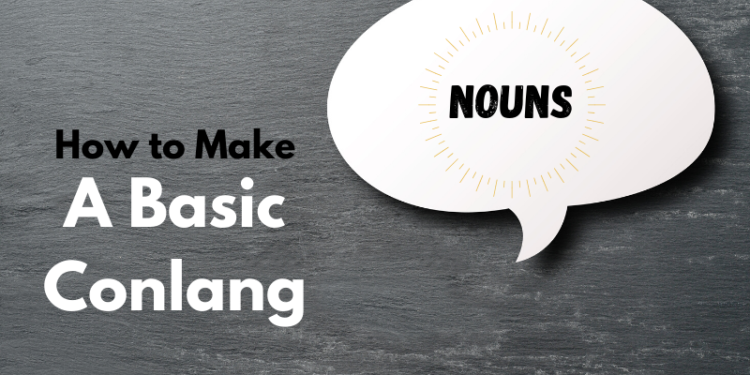How to Make A Basic Conlang, Part 2: Nouns

Last week, we tackled the first step in creating a constructed language: choosing the sounds. It was also pointed out to me that an example lang would be hugely beneficial, so here is my phonology for the Example lang. I also generated a few words for us to play with today.
Example Lang Phonology
I decided to create a language for halflings. I decided to see what would happen if I followed the suggestions I listed out in the last article, so here is what was generated:
Consonants
The consonants will be transcribed into latin letters using the IPA equivalents, except for /ʃ/ and /ʒ/ which will use <sh> and <zh> respectively.
| Labial | Dental | Alveolar | Post- | Palatal | Velar | Glottal | ||
| Nasal | m | n | ŋ | |||||
| Plosive | p | t | k | |||||
| Fricative | unvoiced | f | s | ʃ | h | |||
| voiced | v | z | ʒ | |||||
| Approximant | l | r | j | w | ||||
Vowels
I’ll use a small inventory of /i y e œ a o u/, the diphthongs /ai ei yi oi au eu ou/ and their long counterparts. Long vowels will be transcribed as doubled vowels. /œ/ is transcribed as <oe>.
The syllable structure is C(L)V(C)(S) with these rules:
- L is any approximate
- S is any stop
- consonant clusters either word internally or when followed by a stop. Generally the stops will voice to match the previous sound.
- Stress is always on the first syllable and then on every other one after that.
The words we’ll be playing with are:
- mawi n. horse, mount, domesticated large herbivores like cows more generally.
- kant n. river; road; one’s purpose, meaning or path in life.
- tus n. hand
- tryfk n. boat, wagon
- nal n. man
- tavk n. Third-gendered person
- mjotou n. woman
- hyist v. eat
- kjoet v. go
- shaa v. stand
- ei v. to be
- vota v. to give
Creating Your Grammar
Now let us turn to what has been called the most fun, the most annoying, the most exhilarating, the most frustrating, and the most transcendently divine: Grammar.
Yes, I am serious, when it comes to conlanging, the grammar (or more specifically the language morphology, or how words are arranged to create meaning) is where your language will stop being English but with funny sounds and become a true Conlang. This is not an exhaustive article on all the possibilities, but the goal is to have a conlang more or less hammered out by the end of the process.
I am going to break up this section into Nouns and Verbs. We’ll look at Nouns this week. I’ll also be using an example lang to try to help illustrate some of the concepts. Please let me know if it helps or if it just adds more confusion.
Getting Started
First, we will make a few assumptions:
- The language has only nouns and verbs as the major word types.
- The language is agglutinative (it “glues” bits together to make meaning, like Latin)
- The language has a basic word order of Subject, Object, Verb.
Why these assumptions?
These three parameters are good places to start for people whose language familiarity is mostly connected to Indo-European languages. And they are choices that make the language different enough from English without being too far to be easy to pick up. In fact, these assumptions are things that many Indo-European languages do.
Nouns
At a minimum, you will need to create strategies for how your conlang’s nouns:
- Show number.
- Show their role in the sentence.
You are free to create your language any way you want to, just be sure to have strategies for how your language handles situations where a speaker needs to talk about four orcs or clarify who does what to whom, and so on.
For this build, we’ll assume that our language shows those things on the noun (some natural languages let the verb do most of the heavy lifting).
Number
Nouns can mark for number in a few ways, but as we’ve already decided that our language is agglutinating, we’ll choose some affixes to show plurality.
Your language could be like English and have the nouns only mark for singular and plural, or you can have marking for two of something (dual), three of something (trial), a bunch of stuff (paucal), or even an uncountable mass of stuff (collective), or just one of something (singulative).
Once you’ve chosen what kind of numbers you want your nouns to mark for, let’s choose a strategy:
- A suffix is a bit of sound stuck onto the end of words. English has -(e)s as in dogs and houses. It also has irregular plurals like oxen but that is because of historical changes that are a little beyond the scope of this article.
- An infix is a bit of sound put in between two other syllables. This method is not very productive in English, but I always think of the example of abso-f’ing-lutely, in which the swear word is infixed for emphasis.
- A prefix is the opposite of a suffix and is stuck on the front of a word instead. Like… well, the pre- part in prefix.
Let’s use mawi “horse” as an example.
I’ll decide to use an infix –s- to mark a simple plural (ie. more than one). I’d get maswi for horses.
But what about a word like tus “hand”? Maybe in an instance like that the infix becomes a prefix, giving us situs “hands”. It could be that the si- prefix become so associated with “hands” that it becomes a dual, used for the words for anything that regularly comes in pairs (hands, eyes, feet, moons).
So a new pluralizing strategy gets invented and the suffix -an from the word for “many” tan is shorted and gets smooshed onto the end of words.
So now we have three plurals:
- The infix –s- for nouns with an open initial syllable.
- The prefix si- for duals
- The suffix –an for all other nouns.
This gives us:
Tus “hand” situs “hands”
Mawi “horse” maswi “horses” simawi “two horses
Kant “river” kantan “rivers” sikant “two rivers”
Tryfk “boat” tryfkan “boats, fleet” sitryfk “two boats”
Nal “man” nalan “men” sinal “two men”
Mjotou “woman” mjostou “women” simjostou “two women”
Tavk “third-gender person” tavkan “third-gender people” sitavk “two third-gender people”
Case
Case is how we tell what job a noun is doing. Is it the subject? The object? The indirect object? Think about how in English we have the forms I and me, for the first person singular, and when those two forms are used.
Let’s have these basic cases. More can be added as you develop the language:
Nominative
The Nominative marks the noun as the subject. It does the action of the verb. You can use any of the strategies we discussed in number to create a case marker, or you can choose to leave it unmarked, like in English. Generally its either the nominative or accusative that is left unmarked.
For Examplelang, let’s go with a suffix -(a)r where the a in the parenthesis is added if the noun ends in a consonant.
Nal “man” nalar “man-nom.”
Mawi “horse” mawir “horse-nom.”
Accusative
The accusative marks the object of the sentence, who or what the action is being done to. Because our language is agglutinative, we’ll choose one of the above affixes or we’ll leave it unmarked.
Let’s go with unmarked for Examplelang. So then mawi can be used to mean “horse-acc” and is probably the default case it is in when cited in a dictionary.
Genitive
The genitive is the possessive case. It shows who has or owns what. It can also be used to show that something is composed of something else or from somewhere. Suffixes tend to be the most common kind of affix, so let’s use another one here to create -oerra, and let’s see how it applies to some nouns.
As far as where the genitive noun would appear, wikipedia rescues us again! In SOV languages, genitive noun phrases tend to go before the possessed noun, treating it like a kind of adjective (which also goes before nouns when an SOV language marks nouns instead of verbs for things like case.) Let’s look at some examples:
Mjotou-oerra mawi
woman-genitive horse
The woman’s horse
When we get things like how the final /u/ or mjotou runs into the <oe> of the suffix, we can decide to drop a vowel, or add a sound! Let’s say that in cases where the suffix is between a vowel like /i/ or /u/ and a consonant, the vowel becomes /j/ or /w/ respectively, so we’d actually get:
Mjotowoerra mawi
The woman’s horse
Tusoerra nal
Hand-genitive man
It can be helpful to think “the hand of the man” instead of “the man’s hand” to get the right words declined and in the right order.
Dative
The dative indicates who receives or benefits from an action. Let’s do another suffix, –ky.
Mawiky – “to the man” …so far so good
Tusky – “to the hand”
Tavkky !! Oh no! We have an illegal consonant cluster here! So let’s add an extra vowel to break these up. Let’s go with good ol’ /a/, making the suffix –(a)ky and giving us:
Tavkaky “to the third-gendered person”
Kantaky “to the river”
Woo! All basic cases are done! Next week we’ll look at verbs.



